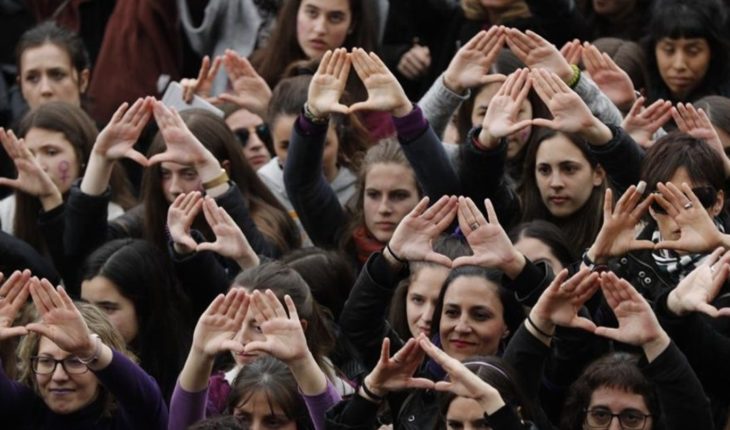There’s no feminism but heaps. The movement, which is broad and absolutely heterogeneous, has very clear objectives but, like any idea, differences. Differences that are raised inside but also fly over the surface. In recent weeks a debate that always seems settled (but not) returned to social media. Are trans people part of the feminist movement? The question is awkward, it’s violent. Do we have to do it? To give rise to a violent discourse, is it to give entity to that violence? As a communicator, I believe that while there are speeches that are not worth echoing, there are others, just as dangerous but also influential that concern and, in the face of that, nothing better than to give the foundations to disarm them. A TERF militant (“Trans-Exclusionary Radical Feminist”) uploaded to her networks a video justifying why trans people should not be part of feminists. Of course, first, they do not call themselves trans-american although in practice they are and second they do not speak in the plural of the movement, although it is necessary to do so. To deny the intersectionality of one of the world’s largest political organizations would be to appeal to the most foolish foolishness. This video, already deleted by the author, was answered by a transfeminist militant (a term that is also uncomfortable because its existence, I believe, legitimizes the idea that there are exclusionary feminations of trans people). The video went viral and filled with comments. Clashes on court 2.0 about ideas that have been discussed decades ago in real life.
Whatsapp accounts and groups of middle-class teens, because for some reason most members of modern radical “feminism” (Radfem) are, add to adeptas. The vulva as a banner and a confusing discourse cajtove a feminism that, if it excludes femininities and rights, far from being. In the videos, the concept “human female” is repeated. It’s your letter. Trans people, they say, are not “human females”, ergo, do not suffer the same kind of violence (women suffer oppression, trans people, discrimination) and that is why they have to military from other places.
To understand what they mean by referring to “human females” and the difference between oppression and discrimination, Filo.News spoke with Alejandra Petino Zappala, a gender biologist and Lara Fuchs, a psychologist and also a specialist in the subject. This note is extensive and complex as the topic it addresses. Before I start reading to our sources, I’m interested in making an otherwise important clarification. If a biologist specialist was consulted, it is not because biology has to determine the right of trans people to their self-perceived identity. That battle, at least in the ID, is already settled. The idea of appealing to biology seeks to disarm the discourse of this sector of feminism, which uses it as a stronghold to repeat and sustain violent convictions which, I believe, must be analyzed carefully. XX, XY, XXY, XXYDETHKNKSJS
We live in a world that structured all its social bases in the division of two genders: males and women. From there, the rest of the stuff. Links, values, goals, problems and solutions. But that binomial has long been being questioned within the sciences and specifically in biology. “We are at a stage where the limits of rigid categories and simplification are beginning to be very noticeable (and this is not just for gender-related issues). People who work in developmental biology, especially, know that an individual is an outcome (which remains constantly modified) of different factors, that we could separate very rudely into genetics and environmental, but that they are not really as independent as it seems”, explains Petino.Si well to separate into two genres can be comfortable and practical to solve some issues, it is problematic when we talk about inclusion since that binomial does not accept any gray. “The idea that most people handle is: XX chromosomes -> woman (with vagina, large breasts, more estrogen etc), XY chromosomes -> man (with penis, more muscular, more testosterone, etc.). But however, development is much more complex, and both hormones, genitalia, secondary characteristics and basically everything we are is much more than chromosomes,” she adds. It is yes, understanding that we are the parties beyond the whole is fundamental in this debate. Not to look at individuals as a general but as a particular but always without losing sight of the collective, is the difficult task that is proposed. “When TERFs say that a trans woman is a male person they are holding an essentialist, reductionist, biological and binary look of sexuality,” fuchs argues, adding, “First of all, you have to understand that sex is a much broader concept than that of biology. It tends to be believed that biological sex exists on the one hand, an easily objectiveable ‘natural’ condition, and gender, which would be the cultural interpretation of this. But if there’s one thing Butler taught us, based on Freud and Foucault’s theory, it’s that sex is as socially constructed as gender. Far from being a set of undistorted, invariable, ‘given’ material characteristics, sex is an insterdisciplinary theoretical construct that has a history.” Just as psychology takes into account, to put it in some way, not only the content but also the journey, from biology, also the reading is integral.
I mean. There are trends, but in turn there are many connectors and specificities that make us who we are. So what are we talking about when we talk about biological sex? Can it be defined or is it also a mixture and everything is confusion? For Petino, biological sex fragments and definitions remain girls. “The point is that we could split the ‘biological sex’ into several parts (chromosomes, hormones, gonads, external and internal genitalia, secondary sexual characteristics) and there are also gender roles and identities, sexual orientation, etc. And they’re not always aligned. If we think statistically, it is true that most 20 people have a vagina, uterus, ovaries, large breasts, less body hair than XYs and are likely to feel comfortable being identified as women. But there are also many other combinations of these characteristics that are less common does not make them as far as valid,” he says. The binarism and denial of the existence of the means and the grays is violence. These readings leave out many people who do not fall under the characteristics that must be had, socially and biologically, to be subject to rights. In this world, if you are not male or female, if you are born in “the medium” between these two ‘biocultural’ concepts, medicine solves it by mutilating and adapting those bodies to the “allowed”. “The assignment of the biological sex that works to this day in medicine is bloody: when a baby is born his genitals are measured with a ‘false rule’, if he measures 0-1cm is an acceptable clitoris, if he measures between 2.5 and 4cm is an acceptable penis, and everything left in the middle is read as a pathology that often triggers in neonate surgeries so that they can fit into the categories we have. Most strikingly, the number of cases in the middle is 1 in 1000, which is no less,” the psychologist says. The worst thing, I think, is that the idea of binarism serves to erase all those people from the environment. We want to believe that what is statistically more common is what it MUST be. And that’s instilled in us from kids: nacés, they look at you if you have a penis or vagina (and poor of you if you were born with ambiguous genitalia because even if you are a newborn baby they will undergo bloody and invasive surgeries to make you “fit” in one of the two boxes), they write you down with a name according to the gender assigned, and from there more or less the socialization is pushing you more and more the extremes,” petino says, adding: “The issue of genital surgeries to babies is a demonstration of how badly we deal with anything that is ambiguous and gets out of female-male duality, and well knows all people who challenge that binarism, because they are likely to try to discipline them many times in life and in very violent ways. We are reinforcing that statistical difference all the time by trying to transform it into something ‘essential’.” Look at which side of the fuse you’re on
TERFs militants repeat over and over again that there are two genera and that those born on one side cannot pretend to be on the other. In the video that was erased by the young woman, she claims that trans people are “male people” after saying three or four times that they are not “human females” as are women. Although the basis of this discourse is violent and discriminatory, they try again and again, to “explain” that for them it is “ok” that trans people exist, but that because they are not “human females” they have to fight for their rights outside of feminists. The tremendous thing about this is that it is even confusing and in that confusion, violence springs in silence. The arguments of TERFs give the Hand to the Church (intimate enemy of many of the feminist struggles) and also purr with the most conservative world leaders. “Today, some governments seem to be following the Roman model, if they are not killing people who do not fit into one of the two containers labeled by sex, at least trying to deny their existence. This month, Prime Minister Viktor Orban of Hungary banned gender curricula at the university level, declaring that ‘people are born male or female’ and that it is unacceptable to ‘talk about socially constructed genders, rather than biological sexes’. Now, the Department of Health and Human Services of the Trump wants to do the same by legally defining sex as ‘a person’s status as a man or woman based on immutable biological traits identifiable before or before birth,'” argues biologist and gender studies specialist Anne Fausto-Sterling in an interesting artipe in the New York Times. humans in one of two categories: male or female. But that terFs, they don’t seem to care too much. It’s a painful thing because they hold military within the feminist movement and fight, it’s supposed, for the same issues and objectives. They march alongside the rest and participate, although often in a chaotic and conflicting way, of the assemblies. But his speech, which I don’t even think is biological because we already have enough evidence that even since biology they question this violent and indoctrinating binarism, it looks a lot like the ideology that feminists seek to defeat. From classification to rights
As we saw, the categories work and serve to accommodate and order a world full of people. But this very world, not at all innocent, has a dominant ideology that uses these labels to control and exercise power from questionable medical standards that woe, since the male-female binomial is constantly questioning.” ‘Human female’ is used in biology and medicine as a classification that can be useful in some contexts, (although it can get in the way of others, especially if you forget that you set up a group of people according to a more or less arbitrary criterion). And probably everyone who uses it, will use a different criterion. For example, in medicine, ‘human female’ is a patient who has a vagina and female secondary characters, but you probably have no idea what sex chromosomes she has,” says the biologist, adding, “It’s like when in physics you talk about a point mass: it’s a concept that doesn’t exist in reality as such but it’s useful for solving a question.” Like Trump, the church or your uncle Carlos, the women who militate within the TERF movement accompany and legitimize a very different discourse than the ones we promote. “It must be understood that behind this discrete and binary categorization of sexuality lies as a strategic purpose to sustain a system of (re)production capitalist that has as a minimum unit the kind family proper to modernity. The binary framework is still a regulatory fiction that reinforces and naturalizes the regimes of power that converge in male and heterosexist oppression,” says Fuchs.That the foundations of your movement are focused on genitality and not cultural intersectionality, in addition to all this, it falls in the same common places where women have been oppressed for decades. “One thing that I think is essential is to take into account that, in the discourse TERF, sexuality is reduced to reproduction. That’s why that reading is a heterosexual matrix and reproduction, the fundamental cog of capitalism is that family. These speeches are 100 years behind and completely unaware of the transfeminist and intersectional contributions of the fourth feminist wave,” she explains. Whoever is free of oppression to throw the first stone
The TERF argument is clear: different violence lived, different struggles. But is it really different? Aren’t in this society the bodies identified by the feminine oppressed? “I remember reading Julia Serano’s Whipping girl a pretty strong argument that transphobia is actually yet another form of misogyny (both when it’s aimed at trans women and trans men). If the world is organized in binary terms (and where on top of the terms on one side they are always ‘superior’ to those on the other) both transphobia and oppression of cis women (and also homophobia, the contempt for what is seen as feminine in cis men) would have a similar origin. Maintaining that difference, preserving binarism, is humiliating and disciplining any individual who does not agree to belong to one of these extremes,” explains the biologist. Perhaps one of the most interesting questions we can ask ourselves is what is actually being a woman? In 1959, Simone de Beauvoir put into check the unquestionable concept of femininity by postulating that “You are not born a woman, you become”. “It is essential to question the ontological construction of the identity category ‘woman’ that is based on a false unity, as if there was a perfectly finished identity. There is no female identity or essence because there is no being behind the making. Identity is in action, it’s performative as Butler says. This means that any genus is a type of imitation that has no original (neither straight, nor cis, nor trans). This applies to cis women as well, badly despite TERFs. This woman, which Simone speaks of, is an act that takes a lifetime. That’s why you can’t reduce everything to primary socialization either, and a psychoanalyst tells you,” says Fuchs.” I don’t think there are two people who suffer exactly the same oppression. There are infinite feminisms based on that intersectionality, there are popular feminisms, transfeminism, Latin American feminism, African-American feminism, in which certain experiences are shared that are more “exclusive” of that group,” Perino adds, and finally, he asks rhetorically, “Why pretend to leave trans women out for that? I don’t see anyone asking for a separate movement for women of popular classes, or movements separated for ethnic reasons, and there are also oppressions that white or middle-class or upper-class feminists don’t suffer.”
translated from Spanish: Disarm the TERF discourse: human females?
April 28, 2020 |





